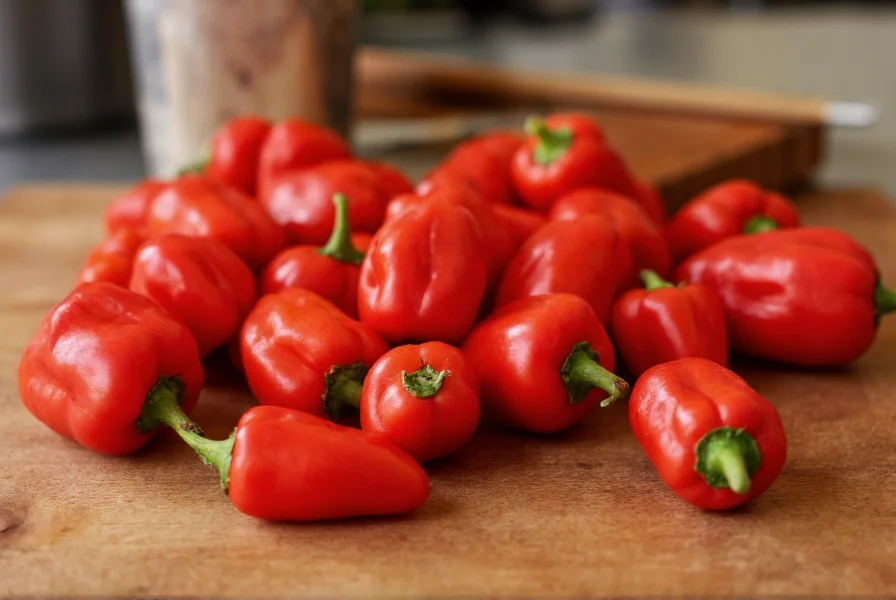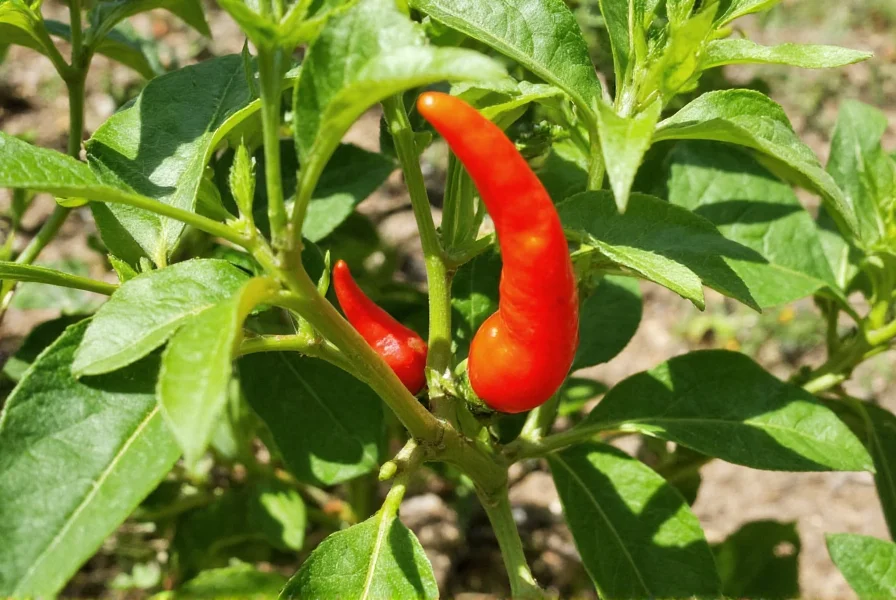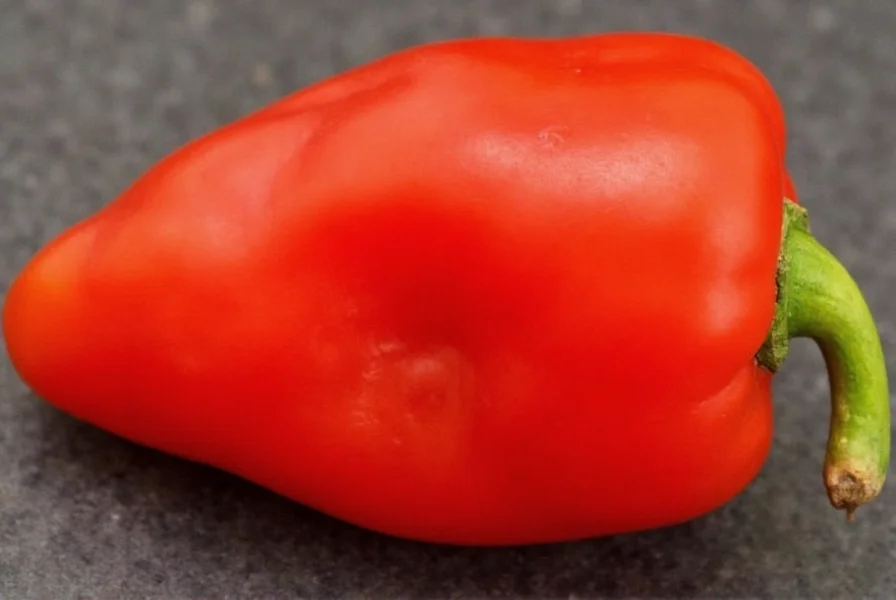The scotch bonnet pepper, scientifically classified as Capsicum chinense, stands as one of the world's most distinctive hot peppers. Native to the Caribbean islands, this chili has become integral to regional cuisines while gaining global recognition among spice enthusiasts and culinary professionals. Its name derives from its resemblance to a traditional Scottish tam-o'-shanter hat, though its cultural significance extends far beyond mere appearance.
Physical Characteristics and Heat Profile
Scotch bonnets typically measure 1-2 inches in diameter with a squat, rounded shape and deeply textured, crinkled skin. Unlike smoother peppers, their distinctive wrinkled appearance indicates higher capsaicin concentration—the compound responsible for heat. When immature, they appear green, transitioning through vibrant yellow and orange stages before reaching their characteristic deep red maturity.
Understanding scotch bonnet pepper heat level requires examining its position on the Scoville scale. These peppers register between 100,000-350,000 Scoville Heat Units (SHU), placing them in the same heat category as habaneros. For context, this makes them significantly hotter than cayenne peppers (30,000-50,000 SHU) and dramatically more intense than jalapeños (2,500-8,000 SHU). The heat builds gradually after consumption, starting with fruity notes before delivering its signature fiery punch.
| Pepper Type | Scoville Heat Units | Flavor Profile | Common Uses |
|---|---|---|---|
| Scotch Bonnet | 100,000-350,000 | Fruity, sweet, tropical | Caribbean sauces, jerk seasoning |
| Habanero | 100,000-350,000 | Citrusy, floral | Mexican hot sauces, salsas |
| Jalapeño | 2,500-8,000 | Grassy, bright | Salsas, nachos, poppers |
Scotch Bonnet vs Habanero: Understanding the Differences
Many people confuse scotch bonnet peppers with habaneros since they share similar heat levels and belong to the same species. However, several key distinctions exist between these two popular hot peppers. The scotch bonnet vs habanero comparison reveals important culinary differences that affect how chefs use them.
While habaneros typically have a more elongated, tapered shape, scotch bonnets maintain a distinctive rounded, almost square appearance with deep folds. Flavor-wise, scotch bonnets offer more pronounced tropical fruit notes—reminiscent of mango, apricot, and citrus—whereas habaneros lean toward citrus and floral undertones. Geographically, scotch bonnets dominate Caribbean cooking, while habaneros feature more prominently in Central American and Mexican cuisine.
Culinary Applications of Scotch Bonnet Peppers
The unique flavor profile of scotch bonnet peppers makes them invaluable in Caribbean cooking traditions. How hot is scotch bonnet pepper in practical culinary terms? Its heat requires careful handling, but the reward is complex flavor that transforms dishes. In Jamaican cuisine, these peppers form the foundation of authentic jerk seasoning, providing both heat and fruity complexity.
Chefs use scotch bonnets in various preparations:
- Hot sauces: The primary ingredient in Caribbean-style hot sauces
- Marinades: Whole peppers often punctured and added to meat marinades
- Chutneys and relishes: Combined with tropical fruits like mango
- Stews and soups: Added for depth of flavor and controlled heat
When working with scotch bonnet pepper uses in cooking, remember that heat distribution varies within the pepper. The placenta (white ribs) contains the highest concentration of capsaicin, while the flesh offers more flavor with less heat. For milder applications, remove seeds and membranes before use.

Safe Handling Practices for Extreme Heat Peppers
Proper handling of scotch bonnet peppers prevents painful burns and accidental exposure. Always wear disposable gloves when preparing these peppers, and avoid touching your face—especially eyes—during and after handling. The oils can remain on surfaces for hours, so thoroughly clean all cutting boards, knives, and countertops with soapy water after use.
If you experience skin irritation from capsaicin exposure, apply milk or yogurt to the affected area rather than water, which spreads the oil. For accidental eye contact, flush with milk or a specialized capsaicin removal solution, not water. Understanding how to handle scotch bonnet peppers safely ensures you can enjoy their flavor without discomfort.
Nutritional Benefits and Growing Considerations
Scotch bonnet peppers offer impressive nutritional value beyond their heat. They're exceptionally rich in vitamin C (more than oranges), vitamin A, and capsaicin—which research suggests may boost metabolism and provide anti-inflammatory benefits. The scotch bonnet pepper nutritional profile makes it a valuable addition to balanced diets when consumed in appropriate quantities.
Gardeners interested in cultivating scotch bonnets should note they require warm temperatures (70-90°F), consistent moisture, and well-draining soil. These peppers need 90-120 days to mature from seed and thrive in tropical or subtropical climates. In cooler regions, grow them in containers that can be moved indoors during temperature drops. The plants typically reach 2-3 feet in height and produce abundant fruit when properly cared for.

Finding and Substituting Scotch Bonnet Peppers
Where to buy scotch bonnet peppers depends largely on your location. In Caribbean communities, they're often available fresh at local markets. Larger grocery chains increasingly stock them in the international or specialty produce sections. For those outside tropical regions, frozen or dried scotch bonnets provide more consistent availability than fresh peppers.
When scotch bonnets aren't available, suitable substitutes include:
- Habanero peppers (closest heat and flavor match)
- Trinidad Moruga Scorpion (hotter alternative)
- Mejilonero peppers (similar flavor profile)
- A blend of serrano peppers with a touch of mango puree
Remember that substitutions require heat adjustment—start with less than the recipe specifies and gradually increase to achieve desired spiciness. The distinctive fruity notes of scotch bonnets make perfect substitution challenging, but creative combinations can approximate their unique flavor profile.
How hot is a scotch bonnet pepper compared to other common peppers?
Scotch bonnet peppers measure 100,000-350,000 Scoville Heat Units (SHU), making them 40-100 times hotter than jalapeños (2,500-8,000 SHU) and comparable to habaneros. They're significantly milder than extreme peppers like the Carolina Reaper (1,400,000-2,200,000 SHU) but much hotter than cayenne peppers (30,000-50,000 SHU).
What's the difference between scotch bonnet and habanero peppers?
While scotch bonnets and habaneros share similar heat levels, they differ in shape, flavor, and culinary use. Scotch bonnets have a rounded, almost square shape with deep folds and offer more tropical fruit notes, while habaneros are more tapered with citrusy, floral flavors. Geographically, scotch bonnets dominate Caribbean cooking, while habaneros feature more in Central American and Mexican cuisine.
Can I grow scotch bonnet peppers in a non-tropical climate?
Yes, you can grow scotch bonnet peppers outside tropical climates with proper care. They require 90-120 warm days (70-90°F) to mature. In cooler regions, grow them in containers that can be moved indoors during temperature drops. Provide consistent moisture, well-draining soil, and at least 6-8 hours of direct sunlight daily. Start seeds indoors 8-10 weeks before the last frost date for best results.
What are the health benefits of scotch bonnet peppers?
Scotch bonnet peppers are rich in vitamin C (more than oranges), vitamin A, and capsaicin. They offer potential health benefits including improved metabolism, anti-inflammatory effects, and cardiovascular support. The capsaicin may help with pain relief and weight management. However, consume them in moderation as excessive amounts can cause digestive discomfort, especially for those with sensitive stomachs.
How should I handle scotch bonnet peppers safely?
Always wear disposable gloves when handling scotch bonnet peppers and avoid touching your face, especially eyes. Thoroughly clean all surfaces and utensils with soapy water after use. If you experience skin irritation, apply milk or yogurt (not water) to the affected area. For accidental eye contact, flush with milk or a specialized capsaicin removal solution. Never use bare hands when preparing these extremely hot peppers.











 浙公网安备
33010002000092号
浙公网安备
33010002000092号 浙B2-20120091-4
浙B2-20120091-4